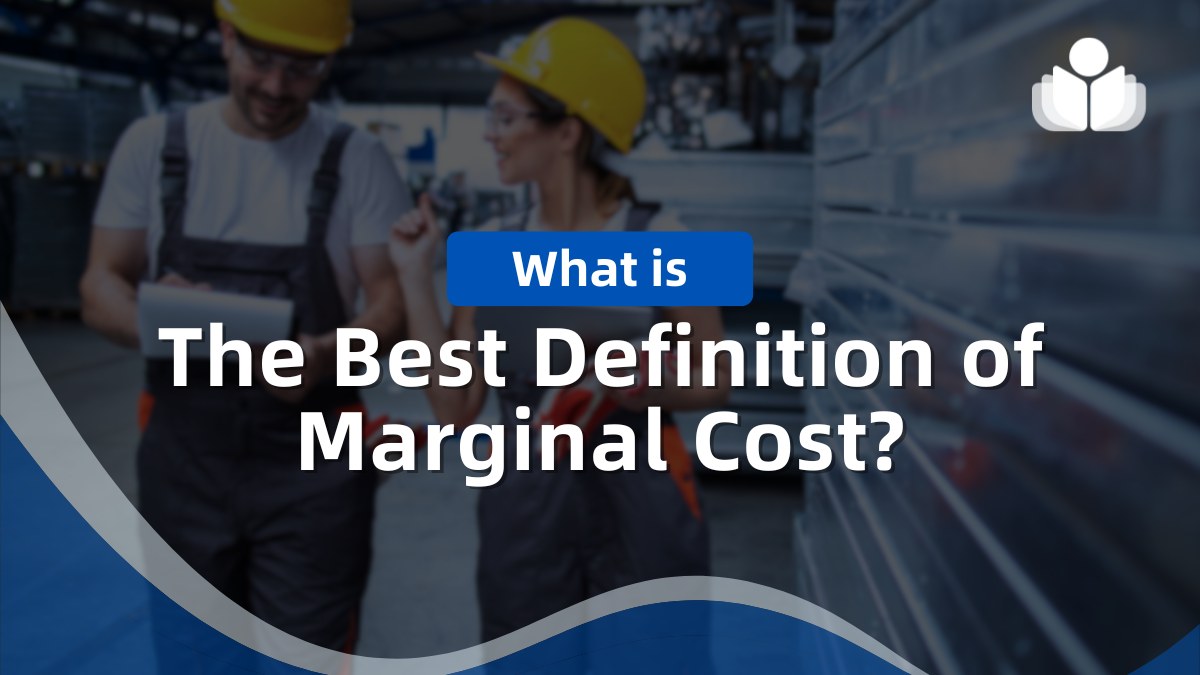Marginal cost is a fundamental concept in economics and business that is critical in decision-making processes. It represents the additional cost incurred by producing one more unit of a good or service.
Understanding marginal cost is essential for businesses to optimize production levels, set prices, and maximize profits. This article explores the definition of marginal cost, its significance, how it is calculated, and its implications in various economic contexts.
Understanding Marginal Cost
At its core, marginal cost is the cost of producing an additional output unit. It helps businesses determine the most efficient production level where costs are minimized, and profits are maximized. The concept can be illustrated through a simple example: if a factory produces 100 units of a product at a total cost of $1,000 and producing 101 units costs $1,010, the marginal cost of the 101st unit is $10.
Calculating Marginal Cost
The formula for calculating marginal cost is straightforward:
Marginal Cost (MC)=ΔTC/ΔQ
Where:
- ΔTC is the change in total cost
- ΔQ is the change in quantity produced
This formula highlights that marginal cost is derived from the change in total cost that results from producing one additional unit of output.
Components of Marginal Cost
Marginal cost comprises various components, including variable costs, fixed costs, and sometimes sunk costs:
- Variable Costs: These are costs that change directly with the production level. Examples include raw materials, direct labor, and energy costs. Variable costs are a significant component of marginal cost since they fluctuate with output levels.
- Fixed Costs: These costs remain constant regardless of the production level, such as rent, salaries of permanent staff, and depreciation. Although fixed costs don’t directly impact marginal cost in the short run, they’re crucial in long-term production planning.
- Sunk Costs: These are costs that have already been incurred and cannot be recovered. Sunk costs shouldn’t influence marginal cost calculations because they don’t change with the level of production.
Significance of Marginal Cost
Marginal cost is a critical factor in various economic and business decisions, including:
- Pricing Strategies: Businesses use marginal cost to set prices. In perfect competition, the price is often set equal to marginal cost. This ensures that firms cover their costs and achieve normal profits. For monopolies, marginal cost helps determine the profit-maximizing price.
- Production Decisions: Marginal cost helps businesses decide the optimal level of production. Firms aim to produce up to the point where marginal cost equals marginal revenue (MC = MR). Producing beyond this point would result in higher costs than revenue, reducing overall profits.
- Resource Allocation: Efficient allocation of resources is vital for economic growth. Marginal cost analysis assists in determining how resources should be allocated among different uses to achieve maximum efficiency.
- Cost Management: Understanding marginal cost helps businesses manage and control costs effectively. By analyzing how costs change with production levels, companies can identify areas for improvement in efficiency.
Marginal Cost in Different Market Structures
Marginal cost plays a unique role in different market structures:
- Perfect Competition: Numerous small firms produce identical products in a perfectly competitive market. Market forces determine the price, and firms are price takers. Here, the marginal cost curve is crucial as it represents the firm’s supply curve in the short run. Firms produce where price equals marginal cost (P = MC).
- Monopoly: A monopolist is the sole producer of a good or service with no close substitutes. The monopolist maximizes profit by producing where marginal cost equals marginal revenue (MC = MR). Unlike in perfect competition, the price is set above marginal cost, leading to higher profits.
- Oligopoly: An oligopoly consists of a few large firms that dominate the market. These firms consider the actions of their competitors when making production and pricing decisions. Marginal cost analysis helps in strategic decision-making, such as setting prices and output levels in response to competitors’ actions.
- Monopolistic Competition: This market structure features many firms selling differentiated products. Firms have some degree of market power and can set prices above marginal cost. However, in the long run, economic profits are driven to zero, and firms produce where price equals average total cost (P = ATC).
Marginal Cost and Economies of Scale
Economies of scale refer to the cost advantages that firms experience as their production scale increases. Understanding the relationship between marginal cost and economies of scale is crucial for businesses seeking to expand production:
- Increasing Returns to Scale: When a firm experiences increasing returns to scale, the marginal cost decreases as production increases. This occurs because fixed costs are spread over a larger number of units, and variable costs may also decrease due to efficiencies gained from large-scale production.
- Constant Returns to Scale: In this scenario, marginal cost remains constant as production increases. The firm’s cost structure doesn’t change significantly with increased output.
- Decreasing Returns to Scale: When a firm experiences decreasing returns to scale, marginal cost increases as production expands. This can occur due to factors such as resource limitations, inefficiencies, or increased complexity in managing larger production volumes.
Marginal Cost and Externalities
Externalities are costs or benefits that affect third parties who aren’t directly involved in an economic transaction. Marginal cost analysis must consider externalities to ensure that the true social cost of production is accounted for:
- Negative Externalities: These are costs imposed on third parties, such as pollution from a factory. The social marginal cost (SMC) includes both the private marginal cost (PMC) and the external cost. Governments often intervene to correct negative externalities through regulations, taxes, or subsidies.
- Positive Externalities: These are benefits enjoyed by third parties, such as improved public health from vaccinations. In this case, the social marginal benefit (SMB) exceeds the private marginal benefit (PMB). Governments may encourage positive externalities through subsidies or public provision of goods and services.
Marginal Cost in Public Goods and Common Resources
Public goods and common resources present unique challenges in marginal cost analysis:
- Public Goods: These are non-excludable and non-rivalrous goods, such as national defense or clean air. The marginal cost of providing an additional unit of a public good is often zero or very low. Efficient provision requires that the marginal social benefit equals the marginal social cost (MSB = MSC).
- Common Resources: These are rivalrous but non-excludable goods, such as fisheries or forests. Overuse of common resources can lead to depletion or degradation. Marginal cost analysis helps in designing policies to manage and conserve common resources effectively.
Marginal Cost and Technological Change
Technological advancements can significantly impact marginal cost:
- Process Innovations: Improvements in production processes can reduce marginal cost by increasing efficiency and reducing waste. For example, automation and lean manufacturing techniques can lower variable costs and enhance productivity.
- Product Innovations: Introducing or improving new products can alter marginal cost structures. Firms must analyze how changes in product design, materials, or features affect production costs.
Marginal Cost in Managerial Decision-Making
Managers use marginal cost analysis to make informed decisions across various business functions:
- Production Planning: Determining the optimal production level involves analyzing marginal cost and marginal revenue. Managers aim to produce where MC equals MR to maximize profits.
- Pricing Strategy: Setting prices requires understanding how marginal cost affects profitability. Managers use marginal cost to determine the minimum price at which products can be sold without incurring losses.
- Cost Control: Identifying and managing factors that influence marginal cost helps in controlling overall production costs. Managers focus on reducing variable costs and improving efficiency.
- Investment Decisions: Evaluating the marginal cost of new investments, such as expanding production capacity or adopting new technology, helps in making sound investment choices.
Marginal Cost and Break-Even Analysis
Break-even analysis is a crucial tool for understanding the relationship between marginal cost, fixed costs, and revenue:
- Break-Even Point (BEP): This is the production level at which total revenue equals total cost, resulting in zero profit. The formula for calculating the break-even point is:
BEP=Fixed Costs / Price−Variable Cost per Unit
- Contribution Margin: This is the difference between the selling price and the variable cost per unit. It contributes to covering fixed costs and generating profit. Understanding the contribution margin helps in pricing and production decisions.
- Margin of Safety: This measures the difference between actual sales and break-even sales. A higher margin of safety indicates a lower risk of incurring losses.
Marginal Cost in International Trade
Marginal cost analysis also plays a significant role in international trade:
- Comparative Advantage: Countries specialize in producing goods for which they have a lower marginal cost relative to other countries. This forms the basis of comparative advantage and international trade.
- Trade Policies: Governments use marginal cost analysis to design trade policies, such as tariffs, quotas, and subsidies. These policies aim to protect domestic industries or promote exports.
Marginal Cost and Cost-Volume-Profit (CVP) Analysis
Cost-Volume-Profit (CVP) analysis examines the relationship between cost, volume, and profit. Marginal cost is a key component in CVP analysis:
- Contribution Margin Ratio: This ratio is calculated by dividing the contribution margin by the selling price. It indicates the portion of sales revenue available to cover fixed costs and generate profit.
- Profit Equation: The basic CVP profit equation is:
Profit=(Selling Price−Variable Cost per Unit)×Quantity−Fixed Costs
Understanding the impact of changes in production volume, costs, and prices on profit is crucial for effective decision-making.
Marginal Cost in Financial Management
Financial managers use marginal cost analysis to evaluate various financial decisions:
- Capital Budgeting: Marginal cost helps in evaluating the cost of additional investments or projects. Financial managers compare the marginal cost with the expected return to determine the viability of investments.
- Cost of Capital: Understanding the marginal cost of different sources of capital, such as debt and equity, helps optimize the capital structure and minimize the overall cost of capital.
- Working Capital Management: Marginal cost analysis assists in managing working capital efficiently by identifying the optimal levels of inventory, receivables, and payables.
Conclusion
Marginal cost is a vital concept in economics and business, influencing pricing strategies, production decisions, and resource allocation. By understanding and analyzing marginal cost, businesses can optimize their operations, control costs, and enhance profitability.
Whether in perfect competition, monopoly, or oligopoly, marginal cost plays a crucial role in determining the most efficient level of production. It also has significant implications for public goods provision, externalities management, technological change, and international trade.
For managers and financial professionals, marginal cost analysis is an indispensable tool for making informed and strategic decisions across various business functions.
 Sections of this topic
Sections of this topic
















